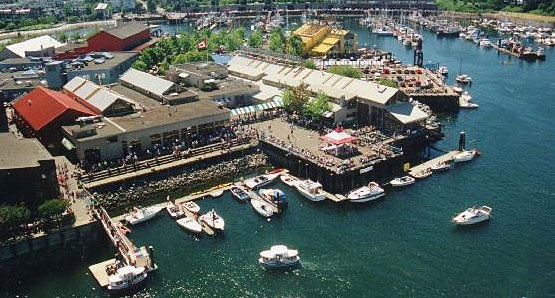|
You can't get a Starbuck's coffee
on Granville Island. Nor, for that matter, can you buy a pair of khakis from
the Gap or order up a Happy Meal from Mickey-D's.
Trivial? Perhaps.
But it is this underlying policy
of "made in Vancouver" consumerism -- no franchise chains, nay to the
multinationals -- that has, for more than 30 years, provided the cornerstone of
the Granville Island experience.
Balanced on this founding philosophy
is a vibrant and diverse community of independent shopkeepers, artists, artisans
and buskers that sets Granville Island apart as a successful public market unique in North America.
The formula has long appeared bulletproof,
drawing 12 million visitors a year to the historic, 16-hectare peninsula in the
heart of Vancouver.
Today, however, there is a growing
sense of unease on the island.
The Canada Mortgage and Housing Corporation
(CMHC), the federal body that governs Granville Island, is looking to make changes for the first time since
taking it over in 1979.
Island Insight -- an exhaustive infrastructure
study nearing completion -- will consider improvements to public access, transportation
and parking, as well as the 19 buildings, seawalls and docks CMHC owns and manages.
All in time for the influx of visitors
expected during the 2010 Olympics.
Many of the island's business and
studio owners are nervous. Change is in the wind, and unlike Granville
Island's signature scent -- a melange of fresh-cut flowers, fried fat and
sun-baked creosote -- many feel there's a bad whiff on the rise.
Joanne and Georges Lefebvre, owners
of the bustling Stock Market in the public market, have worked on the island for
20 years. From cramped quarters, the Lefebvres offer 3,000 varieties of soups
and stocks.
Joanne describes two decades on the
island as "absolutely wonderful."
"In French, we say, 'ludique,'"
she says. "Which means 'playful.'"
But Joanne now wonders what the future
will hold as Granville Island's keepers plan for the next 20 years.
"They must be vigilant about
keeping it small, encouraging the equilibrium of artisans and small business owners,"
she insists.
"The administration seems quite
dynamic and they are being proactive," she adds. "But we will see."
The CMHC's Gloria Loree says the
Lefebvres have nothing to fear. Ditto the 2,500 people who work on the island
and the thousands of Greater Vancouverites who would say of their beloved Granville
Island, "If it ain't broke, don't fix it."
But Loree says that 30 years on,
the crown jewel of Vancouver's tourism industry needs a polish. The island's aging
infrastructure -- pylons, planks and cement hardly touched since 1917 -- requires
maintenance. And increased visitation -- particularly vehicular visits -- has
placed pressures on the island that need to be addressed. It will be a gentle
tweak, insists Lore e.
"We know that the sense of pride
and ownership by the community for Granville Island is extraordinarily high," she says. "People
feel about Granville Island the way they do about their home or
their local park."
So what, exactly, is in store for
Granville Island?
It's early days, but the CMHC's proposed
plans include:
- Widening the island's
docks and expanding its ferry services.
- Ongoing maintenance and
safety improvements for old industrial buildings.
- Working with the City
on linking the island with a proposed False Creek streetcar and/or linking the
island by heritage rail with the coming Canada Line.
- Installing bike lock-ups
and standardizing parking.
Granville Island
artist Hilary Morris says Island Insight will have a "significant impact"
on the future of the island.
"It's important that things
are looked at," says Morris, also a board member of the Granville
Island Business and Community Association. "You
can't just rest on your laurels and hope to remain successful."
The artist is confident CMHC will
maintain the unique blend of activities on which the island was founded.
"Many have tried and many have
failed to create this kind of atmosphere and experience . . . so any sort of tweaking
and changing will be viewed with fear," she says.
Gloria Loree says multinationals
will never be welcome on the island, while vehicles will never be banned.
"You couldn't cut off vehicle
access to the island without some really serious implications to the business
life down here," she says. "There's a certain amount of animation that
comes from having traffic circulation and a lot of our visitors are coming specifically
to buy a lot of groceries."
No, says Loree, the CMHC will instead
offer alternatives such as extra ferries, more bike lock-ups and better rail/transit
links.
As for that Starbuck's coffee? Not
on her watch, says Loree.
"The pressure does not come
from the multinationals. It comes from our community, which says keep Granville
Island unique, keep the chains off," she says. "There is no intention
to move in any other direction."
| 



















